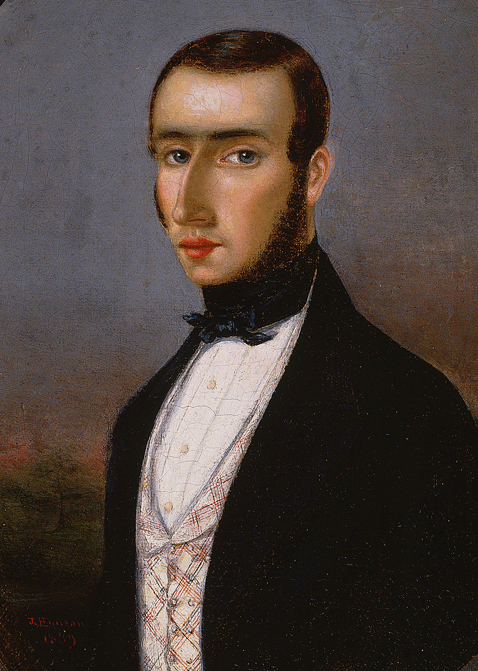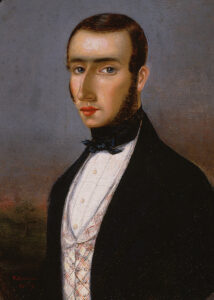Free Black Artists in Antebellum New Orleans
New Orleans' unique three-tiered racial system which accepted free people of color as a separate caste from enslaved blacks provided a unique opportunity for free black artists.

Courtesy of Louisiana State Museum.
Color reproduction of a painted self-portrait of Julian Hudson.
The large class of free people of color in antebellum New Orleans included professional painters, lithographers, marble cutters, sculptors, and other artists. New Orleans’s unique three-tiered racial system—which accepted free people of color as a separate caste from enslaved blacks—provided a unique opportunity for these individuals. While free blacks in other parts of the South faced increasing animosity, some free black artists in New Orleans were able to study with respected artists and go on to successful careers. Though relatively few in number, these black artists frequently interacted with whites, particularly immigrants from Europe, where racism was somewhat less prevalent. As a result, many held European artistic traditions as their ideal.
Painters and Lithographers
The first known African American artist in New Orleans was the painter Louis Pepite, who studied with Italian scene painter Jean Baptiste Fogliardi in the 1820s. While Pepite was his student, Fogliardi painted a triumphal arch that was placed in the Place d’Armes (now known as Jackson Square) to celebrate General Lafayette’s visit to New Orleans in 1825. Fogliardi worked with help from his students, perhaps including Pepite. Pepite continued painting theater scenery through 1834, though none of his work is extant. After 1834, he disappears from the historical record.
More is known about Julien Hudson, a portraitist and miniaturist. Born in 1811, he was the son of a free New Orleans quadroon and an English merchant. In 1826, Hudson began studying with Antonio Meucci, a Roman miniaturist then working in New Orleans. Four years later, Hudson furthered his studies in Paris before opening a studio in New Orleans in 1831. In 1837, he again ventured to Paris—this time to study with Abel de Pujol—before returning to his New Orleans once again. A teacher of art as well as a student, Hudson counted white painter George David Coulon among his pupils. According to community lore, however, Hudson was distraught by his lack of success and destroyed a large number of his paintings. Five works survived and are in museum collections, including the Louisiana State Museum and the Ziegler Museum.
The most prolific of the antebellum artists was Jules Lion, a free man of color born in France circa 1810. Trained as a lithographer in France, Lion immigrated to New Orleans in 1836 or early 1837, where he specialized in portraits. After returning to Paris for a summer, he introduced daguerreotypes— the forerunner of photography—to New Orleans in September 1839. Though Lion made and exhibited daguerreotypes of city landmarks and people, none of these are known to survive.
Increased competition eventually led Lion back to lithography. His most lasting artistic achievement is the series of lithographic portraits he produced, primarily in New Orleans, from 1837 through 1847. In the 1840s, Lion created lithographs of New Orleans city scenes, including a block of Canal Street and the St. Louis Cathedral. In the 1860s, he rendered sheet music covers for New Orleans publishers. After a brief stint as professor of drawing at a night school, Lion died in 1866.
Born in New Orleans around 1825, Louis Lucien Pessou, also a lithographer of considerable talent, was the son of free people of color who had emigrated from Saint Domingue. First listed as a lithographer in the 1853 city directory, he partnered the next year with a German named Benedict Simon. Pessou and Simon pioneered color lithography in New Orleans and became the leading lithographic firm in the city. During the next twelve years, they produced a wide range of lithographs, including maps, plans, book illustrations, city views, and business papers.
Sculptors
The cities of the dead—New Orleans cemeteries with their above ground tombs—provided a living for many New Orleans sculptors. Besides tombs, marble cutters turned their tools to original sculpture, both religious and secular. Most of the skilled sculptors and marble cutters in the city were French or Italian emigrants, but Florville Foy, a free man of color born in 1819, outdid them all.
After learning to sculpt from his father, Foy opened his own studio in 1836. The wardens of the St. Louis Cathedral were among his early clients. Foy also built many of the tombs designed by French architect J. N. B. de Pouilly. Designing tombs and sculpture of his own, Foy varied his style to suit his clients’ tastes. He eventually became one of the most successful marble cutters in New Orleans, and purchased a three-story building on Rampart Street, with an adjoining marble yard, in the 1850s. By the 1880s, he employed a manager and eight artisans. All three Saint Louis cemeteries contain work executed and signed by Foy, and his tombs were shipped as far away as Biloxi and Pensacola.
Like Foy, Eugène Warburg began as a marble cutter but had greater ambitions as a sculptor. Breaking free from funerary art, he achieved a modest international reputation as a sculptor. His father was a wealthy businessman and member of a distinguished German Jewish family. His mother was an enslaved woman of Cuban origin, who was freed after Eugène’s birth in late 1825 or early 1826. The couple’s other children were born free, including Daniel, the youngest, in 1836. With the aid of family friend Pierre Soulé, Warburg’s father freed him in 1840, after his mother’s death.
Warburg studied with Philippe Garbeille, a noted French sculptor, in New Orleans, before setting up shop as a marble cutter in 1849. In his studio, located across from St. Louis Cemetery No. 1, Warburg constructed funerary sculpture and tombs. He also continued to pursue secular sculpture, creating a large marble statue of Ganymede, among other sculptures. (Though it received very favorable publicity, the whereabouts of this sculpture are unknown.) In 1851, at the invitation of the St. Louis Cathedral wardens, he designed and executed the center aisle for the newly rebuilt church. That black-and-white checkerboard marble aisle is still in use today.
Discouraged by the lack of artistic opportunity in America, Warbourg left for Europe in 1852. Before his departure, he trained his younger brother Daniel, who took over the workshop. As large well-capitalized marble yards came to dominate the funerary business, Daniel Warbourg eventually went to work for Weiblen Brothers and enjoyed a notable career as a marble cutter until his death in 1911.
For four years, Eugène Warburg studied and worked in France. In 1855, he was employed to sculpt a portrait bust of John Young Mason, U.S. minister to France. (The classically chaste bust of Mason, now at the Virginia Historical Society, is his only known extant sculpture.) Traveling to London, Warburg reportedly executed a series of bas-reliefs from Uncle Tom’s Cabin for the duchess of Sutherland, an outspoken abolitionist. The duchess and her friend, Harriet Beecher Stowe, along with Pierre Soulé, provided the young man with letters of recommendation. Warburg traveled to Florence and then Rome, where he died in 1859. The New Orleans Bee lauded him as one of the most promising of Louisiana’s native sons.
Three other antebellum black artists can be identified by census and New Orleans city directory listings. Bisynthe Navarre worked as an engraver in 1840–1841, while Alexander Nelder was listed as a sculptor from the 1840s through the 1860s. From 1850 through 1866, Felix Deville was listed as a painter. The only extant work is by Nelder, the imposing tomb of Gabriel Toutant Beauregard in St. Bernard Cemetery.
Conclusion
Like other antebellum artists, black artists in New Orleans often struggled to make a living. Itinerant artists traveled from city to city, searching for new patrons, and only a handful ever achieved financial security and national reputations. Racism clearly limited the number of African Americans aspiring to be artists and the success of those who chose to pursue this career. Still, the climate for black artists was more hospitable in antebellum New Orleans than it would be in years after the Civil War. In the postwar period, the development of virulent white supremacy and Jim Crow laws caused formerly free people of color to lose their status. The artistic success of black artists in the antebellum would not be matched until the late twentieth century.
